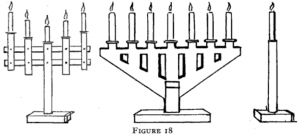The following comes from a 1915 book called “Costumes and Scenery for Amateurs”. I published the first portion of the chapter on props way back in 2009. Here, without further delay, is the conclusion.
Stimulate initiative and invention wherever possible. A round collar box is only a collar box until you use it for an earthen bowl. A white cardboard shoe box is cut down a little, covered with black tissue paper, has a little yellow pane inserted in each side, and a curtain ring for a handle. Behold a lantern for a Yankee minute-man, or Paul Revere, or anyone else who wants to use it.
Remarkable stage furniture can be made from wooden boxes of all sizes. A packing case makes a dais. Several boxes nailed together and stained brown will make a peasant’s cupboard.
Three boxes nailed together like this |¯| will make a hearth. If it is to be a mediæval or fairy tale hearth, cover it with cheap gray cambric, bulked to look like stone, and marked with splotches of white and brown chalk. Be sure you turn the unglazed side of the cambric outward. Use chalk because paint will not show up well on cambric. A brick fireplace for a modern scene can be made in the same way, covering the boxes with brick chimney paper than can be bought at Dennison’s Tissue Paper Co., Boston, Chicago, or New York. One of their catalogues will prove invaluable to directors living in the country. A narrow box on rockers, stained brown, becomes a Puritan or eighteenth century cradle. Gilded and hooded it is the cradle of a royal Princess. Couch seats can be made from boxes, only be sure that they are secure.
Originally published in “Costumes and Scenery for Amateurs”, by Constance D’Arcy Mackay, 1915 (pp 95-96)




